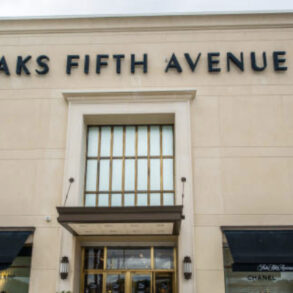Such as With Jean, for example, which was born on the Gold Coast but now sells mostly in Europe and the US, helped no doubt by a pop-up in New York City over the American summer. Launched by friends Sami Lorking-Tanner and Evangeline Titilas, the brand began with “going-out tops” (the kind of thing you might wear… with jeans, hence the name) but now sells everything from swimwear to jewellery.
“Australia was our biggest customer base to begin with,” says Lorking-Tanner. “In the beginning, we had a cult following here. I would drive around and see so many girls wearing it. But the focus has shifted; our biggest markets now are overseas.” To wit: Titilas is now based in Los Angeles, to capitalise on With Jean’s US success.

Founders of Australian fashion brand With Jean, Sami Lorking-Tanner and Evangeline Titilas.
Last year, Forbes valued With Jéan at between $66 million and $110 million, based on 2022 sales of $22 million. It’s a long way from the brand’s beginnings, when $5000 a month in sales was “a big deal”, according to Titilas.
Early seeding with influencers like Bella Hadid and Emily Ratajkowski shifted the dial. “We sent gifts to people all the time; we knew we needed to get it out there. The first year was hard, but the second year we started to see the needle move,” says Lorking-Tanner.




The With Jean pop-up store in Soho, New York City, has been more successful than the owners anticipated.
It was COVID-19, however that really changed things. “We had a deal with a big multi-brand retailer that was meant to launch in March 2020,” says Lorking-Tanner. Everything had been produced, and the pair had already shipped two parts of the orders to the UK and Hong Kong, only to be told the retailer would no longer accept it.
“The deal was off,” says Titilas. Instead, the duo sold the stock themselves, at full price. “It showed us the volume we could sell. At the time it felt like the biggest disappointment in the world, but it showed us what we were capable of,” says Lorking-Tanner.




Réalisation Par launched in 2015 as Instagram shopping was taking off.
The pop-up in New York City’s buzzy Soho has been a resounding success, say the founders. “I thought it would be general foot traffic, but a lot of people are coming specifically to see us,” says Lorking-Tanner. “It’s followers and fans. It’s crazy. People are lined up all the time.”
For Ana Maria Escobar, a similar strategy has paid dividends for LMND in London. A pop-up in Selfridges, complete with an exclusive capsule collection, has exploited the brand’s nascent popularity in Britain and offered fascinating insights into the market.
“We made a collection just for Selfridges and perhaps naively thought that the navy and white shirts would sell best,” says Escobar, “but actually, these women in London want the hot pink, the limoncello, the green. That was the intention of the brand, to have colour and energy, so I feel quite validated.”




Ana Maria Escobar owner and creative director of LMND. “Place of origin is important,” she says.
For Talbot, timing is everything. Launched in 2015, Réalisation Par took full advantage of the direct-to-consumer Instagram boom, propelling the brand well beyond its local origins.
“We launched at a pivotal time when businesses were only just starting to use Instagram,” says Talbot, who is the brand’s design director and is now based in London. “It was really the launching pad of Réalisation.” Selling online and directly to the consumer gave the brand not just a platform but an international sensibility – nobody knew exactly where it came from, and Talbot says this may have been part of its early success.
“Australian fashion was always so … Australia-centric,” she says. “We tried to really focus on the product instead, rather than where we came from. Réalisation uses beautiful silk, the pieces fit well. They are made with care, they make you feel good.” It’s a proposition that transcends geography, she says.




A pop-up in Selfridges helped LMND get to know its English customers’ tastes.
Escobar politely disagrees on this point – for LMND customers, provenance matters.
“It’s nice for people to feel they are discovering something,” she says. “It’s like when we go to Europe and find new brands. We take it for granted because we live here, but Australia is a special, magical place. Telling that narrative through our product is a privilege.”
The fact the product resonates with so many people, far beyond the reaches of her store in Gould Street, Bondi? That’s icing on the cake, she says. “That shirt goes to places I’ve only dreamt of.”
This post was originally published on this site be sure to check out more of their content.








